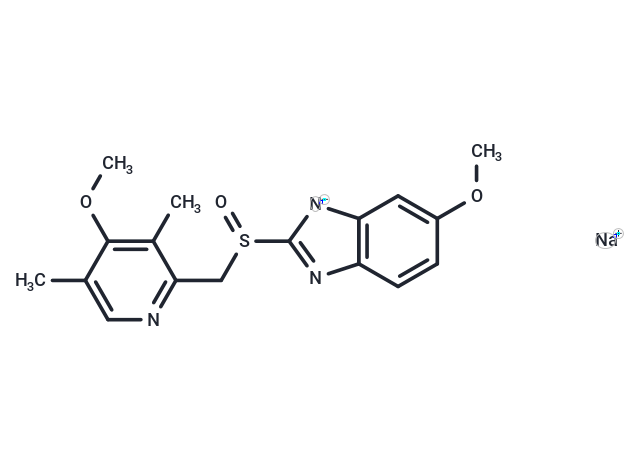Shopping Cart
- Remove All
 Your shopping cart is currently empty
Your shopping cart is currently empty

Omeprazole Sodium is a proton pump inhibitor(PPI) and suppresses gastric acid secretion. Omeprazole Sodium is a potent neutral sphingomyelinase (N-SMase) inhibitor (exosome inhibitor). Omeprazole Sodium shows competitive inhibition of CYP2C19 activity with a Ki of 2 to 6 μM. Omeprazole Sodium inhibits growth of Gram-positive and Gram-negative bacteria.

| Pack Size | Price | Availability | Quantity |
|---|---|---|---|
| 100 mg | $41 | In Stock | |
| 200 mg | $58 | In Stock | |
| 500 mg | $97 | In Stock | |
| 1 mL x 10 mM (in DMSO) | $45 | In Stock |
| Description | Omeprazole Sodium is a proton pump inhibitor(PPI) and suppresses gastric acid secretion. Omeprazole Sodium is a potent neutral sphingomyelinase (N-SMase) inhibitor (exosome inhibitor). Omeprazole Sodium shows competitive inhibition of CYP2C19 activity with a Ki of 2 to 6 μM. Omeprazole Sodium inhibits growth of Gram-positive and Gram-negative bacteria. |
| Targets&IC50 | CYP2C19:2 to 6 μM(Ki) |
| In vivo | Omeprazole Sodium virtually eliminated intragastric acidity in all patients: the median 24 hour intragastric pH rose from 1.4 to 5.3 and the mean hourly hydrogen ion activity fell from 38.50 to 1.95 mmol(mEq)/1 (p less than 0.001)[1] |
| Molecular Weight | 367.4 |
| Formula | C17H18N3NaO3S |
| Cas No. | 95510-70-6 |
| Smiles | O=S(CC1=NC=C(C)C(OC)=C1C)C2=NC3=C([N-]2)C=C(OC)C=C3.[Na+] |
| Relative Density. | 1.37g/cm3 |
| Storage | Powder: -20°C for 3 years | In solvent: -80°C for 1 year | Shipping with blue ice. | ||||||||||||||||||||||||||||||||||||||||
| Solubility Information | DMSO: 120 mg/mL (326.62 mM), Sonication is recommended. H2O: 5.5 mg/mL (14.97 mM), Sonication is recommended. | ||||||||||||||||||||||||||||||||||||||||
Solution Preparation Table | |||||||||||||||||||||||||||||||||||||||||
H2O/DMSO
DMSO
| |||||||||||||||||||||||||||||||||||||||||

Copyright © 2015-2025 TargetMol Chemicals Inc. All Rights Reserved.